
Treatment Accessories
Please click the product you want to learn more about:
Contour Plotting
Model 146-801
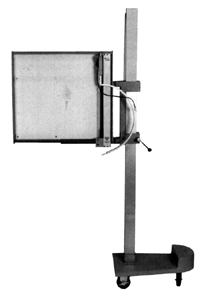
Mobile Contour Plotter
The Model 146-801 Mobile Contour Plotter was developed as a simple system to accurately and rapidly transfer the patient’s surface contour to a sheet of paper while the patient is on a simulator table, treatment table or stretcher. This contour drawing can then be used on the treatment plan and made a permanent part of the patient’s record.
The contour plotter is a mechanical device which links a drawing pen to a stylus arm. Upon contact with the body, it translates body contours to an overhanging drawing board. When the finger plunger is depressed, engaging the pen, a continuous plot is drawn as the operator follows the physical contour of the patient. Marks can be made along the contour to indicate beam entry and laser light locations.
The pen can be of any type — pencil, ballpoint pen or fine felt tip marker. The pen is secured in a special holder with a thumb screw so that the tip is about 1/2" or less from the paper. Pen to paper engagement is through a cable by a finger-controlled plunger. The finger-engaging system is attached to the aluminum stylus arm, allowing easy engagement of the plunger while following the contour with the stylus. The nylon stylus tip is not cold to the body’s touch and is designed to permit skin contact even in the close spacing between the table top and the patient.
The drawing board can rotate 360°. It can lock at any angle, enabling lateral and sagittal contours. The counter-balanced drawing board is easily adjustable in height to accommodate different patient thicknesses and table heights commonly encountered in radiotherapy departments.
It is recommended that computer plotting paper be used for taking contours due to its surface hardness and smoothness; other papers with the same characteristics will also work. Paper can be secured to the board with masking tape.
Swivel and locking casters allow the unit to be easily positioned or transported to various areas of the department.
Mold Room
Styro-former®
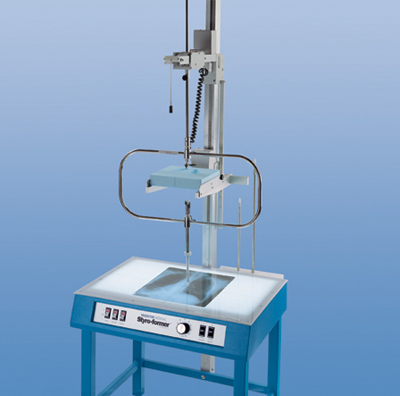
Shielding Block Mold Cutter
The Styro-former® is accurate. A short wire in a rigid box frame keeps the cutting wire tight. There is no perceptive bowing when cutting and it is never necessary to apply pressure downward to keep the wire tight. Accuracy is assured, there is less waste both in time and material, and training of personnel is much quicker.
The Styro-former® is easy to operate. The spring-loaded Teflon stylus moves freely in any direction, just like writing with a fine writing pen. It is unhampered by the limitations of an X and Y axis, giving the operator complete maneuverability. Adjustment for desired treatment height is made by a rotating friction drive system operating against the back of the column. This feature greatly eases raising and lowering of the block tray and the universal joint swivel.
The Styro-former® allows fast, smooth operation. The source point and block tray are joined together by a calibrated tie rod or by the Styro-former® Power Lift. Once adjustment to your particular treatment machine has been made, the two components can be moved as a unit to any treatment position. This also means that the technologist’s working area remains stationary — always at a comfortable desktop working height. The adjustable block holder and verification light are standard. The entire unit is self-standing, requiring no drilling or bolting into the wall.
The Styro-former® can be used with any treatment machine, giving it universal application.
Portal Imaging
Flexi-Holder®
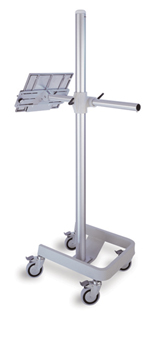
Portal Film Cassette Holders
A free-standing film cassette holder eliminates retakes caused by improper cassette positioning. By replacing sandbags and jerry-rigged holders, a free-standing cassette holder permits smoother scheduling and superior X-ray images.
The Flexi·Holder® Model 303-26.5 is remarkably versatile, allowing X-rays to be taken in virtually any angle from floor level to 71+ inches high. It rolls or swivels into position on large casters, tilts the cassette 180°, rotates the cassette 360° vertically or horizontally and telescopes 26+ inches over the X-ray or operating table.
The telescoping arm is counterweighted for easy raising and lowering. A lip on the cassette holder enables the cassette to be inserted with one hand if necessary. Calibration scales on the column and arm encourage exact, repeatable angulation.
The sturdiness of the Flexi·Holder® assures both safety and stable positioning. Convenient ratchet handles can be repositioned easily to eliminate interference problems when positioning cassettes. It accepts virtually any type or size of cassette and does not obscure the cassette film area.
The Flexi·Holder® Model 303-36 is identical in construction and features but with a 36" arm to negotiate around beam stoppers or to place the Flexi-Holder further from a drop floor.
High Mobility & Table Top

Film Cassette Holders
The high mobility film cassette holder is available in two models – one with vertical tilt only, the other with verticle and horizontal tilt capabilities. The high mobility cassette holder is extremely economical and allows fast, steady positioning. The unit rolls on three low-friction swivel casters with toe-operated brakes.
Verticle and horizontal adjustments are quick and precise. Angular, horizontal and vertical adjustments are secured by a single turn of locking knobs. The holder can accomodate film cassette sizes from 8" x 10" to 14" x 17".
The high mobility film cassette holder features strong metal construction with a baked-on enamel finish that makes it very durable.
Positioning
Superflab Bolus Material
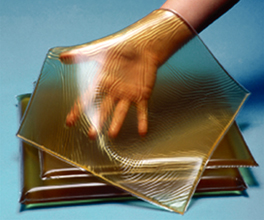
Superflab bolus material is offered in thicknesses which provide maximum dose build-up for relevant photon energies. Since the material does not suffer inelastic strain from normal stresses, it does not have to be bagged or wrapped in plastic film to maintain its shape.
At the option of the user, however, Superflab may be wrapped in disposable plastic film for cleanliness and use, or it may be washed with soap and water as needed, followed by an application of talcum powder or corn starch.
Superflab slabs are elastic and quite "flabby". The material conforms nicely to the patient’s contour while still maintaining good uniformity of thickness.
The dosimetric properties of Superflab were determined by comparison with polystyrene of various thicknesses, using both photon and electron beams of various energies. Subsequently, it was compared with water and was found to be closer to simulation of water than polystyrene.
Since this vinyl gel has both an electron build-up characteristic and a density closer to that of water than polystyrene (long accepted as a standard), it is anticipated this flexible tissue substitute will find wide acceptance in radiotherapy departments.
Although Superflab exhibits very little cold flow, it is best stored flat, not folded. Because Superflab is an oil gel, care must be taken because the synthetic oils can damage plastic surfaces, particularly vinyl-covered furniture.
Model 260-000 Bite Block System
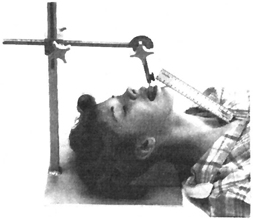
Model 260-000 Bite Block System is a stand-alone patient head immobilizer system that needs no fixing to a treatment table and can be moved from room to room. The aluminum base plate has protruding pins which fit into the holes in the bottom of six different sized head-neck supports, thus locating it to a fixed position every time it is being used. In some treatment set-ups it may be necessary to angle the head to the right or left. For these treatments, place the horizontal adjustable base on the base plate and lock in the position with two thumb screws. The head-neck supports also fit onto protruding pins located on the horizontal adjustable base plate or the pediatric adjustable base plate.
A three lock system allows for easy adjustment and reproducibility. Vertical and horizontal adjustment is accomplished using 15cm scales and two locking knobs. The bite block tray angle is adjustable using a 180° scale and is locked with a knob.
An easy-to-remove individualized bite tray uses dental impression material. The impression procedure takes ten minutes using dental impression material (Model 266-100), available as an optional item. One pack will do 15 to 25 patients.
A fast setup can be accomplished by using the Nasal or Bridge trays. Rest the patient’s head in the correct head-neck support, adjust the head for the desired chin-to-sternal stretch distance, lower the nasal or bridge tray and lock.
Head & Neck Support

Model 248-000 Foam Rubber Head-Neck Support Set
Six different heights and contours provide the versatility needed to attain the desired head angulation. Designed to fit the average adult head, these supports are soft enough to be comfortable for the patient, but firm enough to prevent "sinking" after the head is set.
Use of the Head-Neck Support improves treatment accuracy by helping to ensure the same head position from day-to-day while the cradle helps prevent inadvertent rotation.
These supports are especially valuable for the following situations :
Lateral and anterior fields of the head and neck regions; improving head extension with treating mantle fields; as a general use pillow; adaptable as a forehead and anterior neck support when treating posterior spine and brain fields.
Model 248-000 Head-Neck Supports are made of molded polyurethane foam with a smooth durable surface. They are easily cleaned with water or alcohol and each support is lettered for easy identification.
This product is not intended to provide complete immobilization or to be totally radiolucent, although the attenuation is minimal. Furthermore, because of a possible skin reaction, it is recommended that radiation treatments not be given in such a manner that the beam passes through the support before reaching the skin.
It is supplied in a set of six of assorted sizes, "A" through "F"".
Model 249-000 Silverman Clear Plastic Head-Neck Support Set
Model 249-000 Head-Neck Supports are made of thin, clear plastic material. The plastic thickness ranges between 0.75mm and 1.5mm. They are the same size and shape as the foam-rubber head-neck supports and carry the same letter sequence for identification. There is minimal or no skin reaction observed when treatments have been given directly through these supports. Normally no transmission correction needs to be applied for most high-energy beams. The product, however, is not intended to provide complete immobilization. Supplied in a set of six of assorted sizes, "A" through "F".
Body Calipers
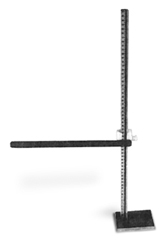
The body calipers are designed with a unique measurement safety feature. The measurement safety is accomplished with one scale and a non-removable slide that prevents errors caused by reading the wrong scale on a dual scale of combination calipers. The slider can be locked at any patient thickness.
Head-Neck Caliper
The head-neck caliper is useful in measurements of either patient diameters or surface-to-tumor depths. The depth of a tumor or intraoral structure relative to either the lateral or anterior/ posterior surfaces can be easily determined. Vertical adjustment is 23cm, horizontal adjustment is 26cm.
Table Top Caliper
The table top caliper with a 55cm scale can only be used to measure from the table top to the top surface of the patient.
Under/Over Table Body Caliper
The under/over table body caliper with a 55cm scale measures 6.5" from the base plate to the curve blade. The blade is 15.5" long.
Body Caliper with Flat Blade
The lightweight body caliper with a flat blade is used for measuring body parts. The rigid leg that slips under the patient is 1/8" thick and 11" long. The scale is available in 45cm and 55cm lengths.
Body Caliper with Curved Blade
This lightweight precision body caliper is used for measuring body parts. The rigid leg that slips under the patient is 1.8" thick and 11" long. The scale is available in 45cm and 55cm lengths.
Model 270-000 Breast Bridge
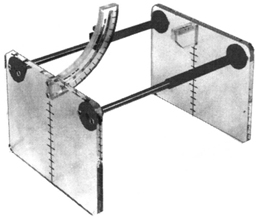
The breast bridge aids in setting up portals for tangential breast treatment. After the area to be treated has been marked, the breast bridge is placed on the patient’s chest and adjusted to the skin markings, thus determining the separation of the fields. The angulation of the portals is determined from the ball protractor as on Model 270-000. If the radiation unit cannot be rotated, the patient may be propped by tilt board or a spine wedge until the spirit level on the bridge shows that the plastic plates are vertical. Once the portals are set, the breast bridge may be removed.
These plates measure approximately 15cm x 20cm and have inscribed center lines. They can be set for separations from 15cm to 35cm. The ball protractor provides angulation readings from 15° to 80°.
Breast Bridge Compressors
The Breast Bridge Compressor is used to compress the breast, particularly when it is desired to increase the dose to the residual mass at the end of a course of treatment. The aluminum mesh and frame are coated with a vinyl plastic for minimum skin dose. The blue vinyl plastic is smooth and warm to the touch.
Testicle Shields & Holders
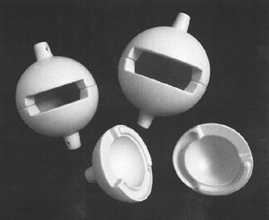
Testicle Shields
These lead shields, available in three sizes, are designed to eliminate and reduce scatter radiation to the testicles.
Each unit is cast to provide a wall thickness of 1/2" and features an open sector to allow comfortable attachment to the patient. All surfaces are coated with a beige polyurethane paint to reduce lead exposure. The shields’ top and bottom sections are secured with two rubber straps (supplied with each unit) or may be secured with nylon tape. When using the stand, no straps are needed. A special dome and groove design between the two halves stops radiation leakage and prevents the halves from sliding apart. Rotating the entrance of the shield toward the ceiling will also reduce scatter radiation from entering the shield.
A soft cotton sock can be used to cover the testicles when placing them inside a cold shield.
Model 275-000 Testicle Retractor
Designed to move all or part of the testicle and scrotum out of the direct beam while irradiating a portion of the scrotum. Constructed of sturdy, clear acrylic, this T-shaped device features a grooved adjustment blade that easily adjusts to any vertical or angled position, then locks into place with a turn of a knob.
Model 928-505 Testicle Shield Stand
This easily adjustable shield stand will cradle testicle shields, offering increased patient comfort while raising and lowering the testicle shield. A hand knob allows for easy vertical adjustment from 1" to 10" at five turns per inch. A plastic plate secured to a cast iron counter-weighted base provides easy positioning. It can be used for anterior and posterior treatments. Testicle shields that incorporate the dome and groove interlocks do not require rubber straps to hold the shield halves together when used with this stand.
Eye Shielding
Tungsten Eye Shields
For Electron & Superficial Shielding
Tungsten eye shields have been developed to provide greater shielding than lead for the same thickness and superior electron scatter properties. Tungsten eye shields can be gas sterilized or autoclaved. Each tungsten eye shield has a removable 1mm thick and 0.5mm thick anodized aluminum cap (both are included with each eye shield) that additionally reduces radiation backscatter to the eyelid. The entrance dose rate will determine whether the 1mm or 0.5mm aluminum cap is to be used. The eye shields can be used without the aluminum cap when treating superficially. Tungsten shields are available in 2mm and 3mm thicknesses and five different diameters. A stainless steel knob provides a convenient handle.
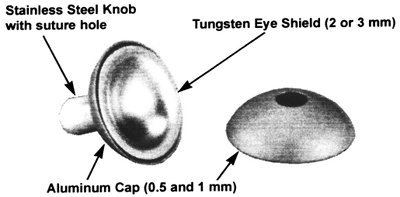
Lead Eye Shields
Silver-Plated Lead Eye Shields
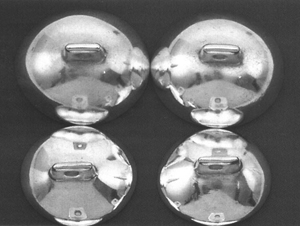
Eye shields protect the patient’s eye during radiation therapy treatments. They are silver-plated and highly polished to fit smoothly under or over the eyelid.
The small and medium-sized cups fit under the lid to protect the lens while permitting irradiation of the entire thickness and width of the lids in treatment of superficial basal cell carcinomas of the skin. When only a portion of the lid requires irradiation, an extra large cup with a window is properly placed over the lid. The large solid lead cups are used when areas surrounding the eyes require irradiation, in which case the cups are placed over the eyeball and lid.
A complete set consists of four pairs ranging from small, medium and large sizes, and one extra large pair with windows. It is supplied in a velvet-lined storage/carrying case. The eye shields are fabricated of virgin lead, 1/16" thick, and silver-plated for a smoother surface and long life protection. Additionally, a dental boxing wax should be used over the silver-plated lead eye shield to prevent scratching or irritation to the eyeball and for reduction of electron scatter.
The lead permits less than 1% transmission of the radiation intensity at 120 kVp (3mm Al HVL). 6MeV electrons have had a 16-25% transmission factor. Electron backscatter from eye shields has been reported to be 40-50%. Lead eye shields are not autoclavable; gas sterilization is required. Always consult the Radiation Physicist when using eye shields with electrons. Please refer to the following paper: Field Shaping in Electron Beam Therapy, by F.M. Khan, Ph.D., Oct. 1976, British Journal of Radiology.
